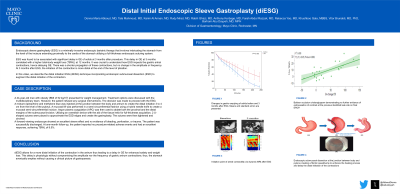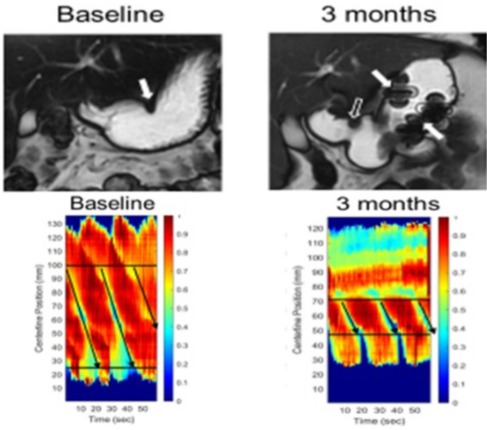Monday Poster Session
Category: Endoscopy Video Forum
P1798 - Distal Initial Endoscopic Sleeve Gastroplasty


Donna Maria Abboud, MD
Mayo Clinic
Rochester, MN
Presenting Author(s)
Mayo Clinic, Rochester, MN
Introduction:
Endoscopic sleeve gastroplasty (ESG) is a minimally invasive endoscopic bariatric therapy that involves imbricating the stomach from the level of the incisura extending proximally to the cardia of the stomach utilizing a full-thickness endoscopic suturing system.
ESG was found to be associated with a significant delay in GE of solids at 3 months after procedure. This delay in GE at 3 months correlated with a higher total-body weight loss (TBWL) at 12 months. It was crucial to understand how ESG impacts the gastric antral contractions, hence delaying GE. There was a shorter propagation of these contractions, but no change in the amplitude or frequency (figure1). At 3 months after ESG, the initiation of the contraction is more distal at the end of the level of plication.
In this video, we describe the distal initiation ESG (diESG) technique incorporating endoscopic submucosal dissection (ESD) to augment the distal initiation of the contraction.
Case Description/Methods:
A 44-year-old man with obesity (BMI of 52 kg/m2) presented for weight management. Treatment options were discussed with the multidisciplinary team. However, the patient refused any surgical interventions. The decision was made to proceed with the ESG.
A mixture of epinephrine and methylene blue was injected at the junction between the body and antrum to create the distal initiation 3 to 4 cm from the level of the pylorus. A mucosal lift was performed in a semi-circumferential fashion using a hybrid needle knife to create a mucosal semi-circumferential incision. Argon plasma coagulation (APC) was then used to ablate both the proximal and the distal margins of the submucosal incision. Utilizing an overstitch device with the aid of the tissue helix for full-thickness acquisition, 2 U-shaped sutures were placed to approximate the ESD edges and create the gastroplasty. The sutures were then tightened and cinched.
The patient was successfully discharged. At one-month follow-up, the patient reported no procedure-related adverse events and had an excellent response, achieving TBWL of 9.5%.
Discussion:
The diESG allows for a more distal initiation of the contraction in the antrum thus leading to a delay in GE for enhanced satiety and weight loss. This delay is physiologic without compromising the amplitude nor the frequency of gastric antrum contractions; thus, the stomach eventually empties without causing a clinical picture of gastroparesis.

Disclosures:
Donna Maria Abboud, MD, Tala Mahmoud, MD, Karim Al Annan, MD, Rudy Mrad, MD, Rabih Ghazi, MD, Anthony Kerbage, MD, Farah Abdul Razzak, MD, Rebecca Yao, MD, Khushboo Gala, MBBS, Vitor Brunaldi, MD, PhD, Barham Abu Dayyeh, MD, MPH. P1798 - Distal Initial Endoscopic Sleeve Gastroplasty, ACG 2023 Annual Scientific Meeting Abstracts. Vancouver, BC, Canada: American College of Gastroenterology.
